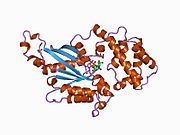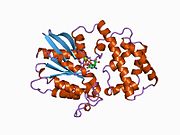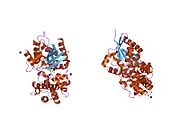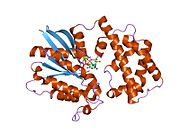GNAI3
| edit |
| Guanin nukleotid-vezujući protein (G protein), alfa inhibirajući polipeptid 3 | |||||||||||
|---|---|---|---|---|---|---|---|---|---|---|---|
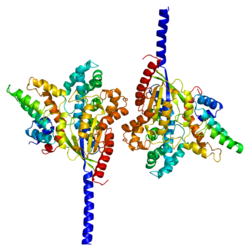 PDB prikaz baziran na 1agr. | |||||||||||
| Dostupne strukture | |||||||||||
| 1agr, 1as0, 1as2, 1as3, 1bh2, 1bof, 1cip, 1gdd, 1gfi, 1gg2, 1gia, 1gil, 1git, 1gp2, 1kjy, 1svk, 1svs, 1y3a, 2g83, 2gtp, 2hlb, 2ihb, 2ik8, 2ode | |||||||||||
| Identifikatori | |||||||||||
| Simboli | GNAI3; 87U6; FLJ26559 | ||||||||||
| Vanjski ID | OMIM: 139370 MGI: 95773 HomoloGene: 55975 GeneCards: GNAI3 Gene | ||||||||||
| |||||||||||
| Pregled RNK izražavanja | |||||||||||
 | |||||||||||
 | |||||||||||
 | |||||||||||
| podaci | |||||||||||
| Ortolozi | |||||||||||
| Vrsta | Čovek | Miš | |||||||||
| Entrez | 2773 | 14679 | |||||||||
| Ensembl | ENSG00000065135 | ENSMUSG00000000001 | |||||||||
| UniProt | P08754 | Q3TJH1 | |||||||||
| RefSeq (mRNA) | NM_006496 | NM_010306 | |||||||||
| RefSeq (protein) | NP_006487 | NP_034436 | |||||||||
| Lokacija (UCSC) | Chr 1: 109.89 - 109.94 Mb | Chr 3: 108.24 - 108.27 Mb | |||||||||
| PubMed pretraga | [1] | [2] | |||||||||
GNAI3, Guanin nukleotid-vezujući protein G(i), alfa-3 podjedinica, je protein koji je kod ljudi kodiran GNAI3 genom.Didsbury JR, Snyderman R (Aug 1987). „Molecular cloning of a new human G protein. Evidence for two Gi alpha-like protein families”. FEBS Lett 219 (1): 259–63. DOI:10.1016/0014-5793(87)81228-0. PMID 3109953.</ref>[1]
Za GNAI3 je bilo pokazano da ostvaruje interakcije sa RGS14,[2] RIC8A,[3] RGS18,[4][5] S1PR1,[6] RGS12,[2] RGS16,[7][8] RGS19,[9][10][11] RGS10[12] i RGS5.[7][13]
- ↑ „Entrez Gene: GNAI3 guanine nucleotide binding protein (G protein), alpha inhibiting activity polypeptide 3”.
- ↑ 2,0 2,1 Kimple, R J; De Vries L, Tronchère H, Behe C I, Morris R A, Gist Farquhar M, Siderovski D P (August 2001). „RGS12 and RGS14 GoLoco motifs are G alpha(i) interaction sites with guanine nucleotide dissociation inhibitor Activity”. J. Biol. Chem. (United States) 276 (31): 29275–81. DOI:10.1074/jbc.M103208200. ISSN 0021-9258. PMID 11387333.
- ↑ Tall, Gregory G; Krumins Andrejs M, Gilman Alfred G (March 2003). „Mammalian Ric-8A (synembryn) is a heterotrimeric Galpha protein guanine nucleotide exchange factor”. J. Biol. Chem. (United States) 278 (10): 8356–62. DOI:10.1074/jbc.M211862200. ISSN 0021-9258. PMID 12509430.
- ↑ Yowe, D; Weich N, Prabhudas M, Poisson L, Errada P, Kapeller R, Yu K, Faron L, Shen M, Cleary J, Wilkie T M, Gutierrez-Ramos C, Hodge M R (October 2001). „RGS18 is a myeloerythroid lineage-specific regulator of G-protein-signalling molecule highly expressed in megakaryocytes”. Biochem. J. (England) 359 (Pt 1): 109–18. DOI:10.1042/0264-6021:3590109. ISSN 0264-6021. PMC 1222126. PMID 11563974.
- ↑ Gagnon, Alison W; Murray David L, Leadley Robert J (July 2002). „Cloning and characterization of a novel regulator of G protein signalling in human platelets”. Cell. Signal. (England) 14 (7): 595–606. DOI:10.1016/S0898-6568(02)00012-8. ISSN 0898-6568. PMID 11955952.
- ↑ Lee, M J; Evans M, Hla T (May 1996). „The inducible G protein-coupled receptor edg-1 signals via the G(i)/mitogen-activated protein kinase pathway”. J. Biol. Chem. (UNITED STATES) 271 (19): 11272–9. DOI:10.1074/jbc.271.19.11272. ISSN 0021-9258. PMID 8626678.
- ↑ 7,0 7,1 Chen, C; Zheng B, Han J, Lin S C (March 1997). „Characterization of a novel mammalian RGS protein that binds to Galpha proteins and inhibits pheromone signaling in yeast”. J. Biol. Chem. (UNITED STATES) 272 (13): 8679–85. DOI:10.1074/jbc.272.13.8679. ISSN 0021-9258. PMID 9079700.
- ↑ Beadling, C; Druey K M, Richter G, Kehrl J H, Smith K A (March 1999). „Regulators of G protein signaling exhibit distinct patterns of gene expression and target G protein specificity in human lymphocytes”. J. Immunol. (UNITED STATES) 162 (5): 2677–82. ISSN 0022-1767. PMID 10072511.
- ↑ De Vries, L; Elenko E, Hubler L, Jones T L, Farquhar M G (December 1996). „GAIP is membrane-anchored by palmitoylation and interacts with the activated (GTP-bound) form of G alpha i subunits”. Proc. Natl. Acad. Sci. U.S.A. (UNITED STATES) 93 (26): 15203–8. DOI:10.1073/pnas.93.26.15203. ISSN 0027-8424. PMC 26381. PMID 8986788.
- ↑ Woulfe, D S; Stadel J M (June 1999). „Structural basis for the selectivity of the RGS protein, GAIP, for Galphai family members. Identification of a single amino acid determinant for selective interaction of Galphai subunits with GAIP”. J. Biol. Chem. (UNITED STATES) 274 (25): 17718–24. DOI:10.1074/jbc.274.25.17718. ISSN 0021-9258. PMID 10364213.
- ↑ De Vries, L; Mousli M, Wurmser A, Farquhar M G (December 1995). „GAIP, a protein that specifically interacts with the trimeric G protein G alpha i3, is a member of a protein family with a highly conserved core domain”. Proc. Natl. Acad. Sci. U.S.A. (UNITED STATES) 92 (25): 11916–20. DOI:10.1073/pnas.92.25.11916. ISSN 0027-8424. PMC 40514. PMID 8524874.
- ↑ Hunt, T W; Fields T A, Casey P J, Peralta E G (September 1996). „RGS10 is a selective activator of G alpha i GTPase activity”. Nature (ENGLAND) 383 (6596): 175–7. DOI:10.1038/383175a0. ISSN 0028-0836. PMID 8774883.
- ↑ Zhou, J; Moroi K, Nishiyama M, Usui H, Seki N, Ishida J, Fukamizu A, Kimura S (February 2001). „Characterization of RGS5 in regulation of G protein-coupled receptor signaling”. Life Sci. (England) 68 (13): 1457–69. DOI:10.1016/S0024-3205(01)00939-0. ISSN 0024-3205. PMID 11253162.
- Downes GB, Gautam N (2000). „The G protein subunit gene families.”. Genomics 62 (3): 544–52. DOI:10.1006/geno.1999.5992. PMID 10644457.
- Sidhu A, Niznik HB (2000). „Coupling of dopamine receptor subtypes to multiple and diverse G proteins.”. Int. J. Dev. Neurosci. 18 (7): 669–77. DOI:10.1016/S0736-5748(00)00033-2. PMID 10978845.
- Jiang M, Pandey S, Tran VT, Fong HK (1991). „Guanine nucleotide-binding regulatory proteins in retinal pigment epithelial cells.”. Proc. Natl. Acad. Sci. U.S.A. 88 (9): 3907–11. DOI:10.1073/pnas.88.9.3907. PMC 51562. PMID 1902575.
- Carty DJ, Padrell E, Codina J, et al. (1990). „Distinct guanine nucleotide binding and release properties of the three Gi proteins.”. J. Biol. Chem. 265 (11): 6268–73. PMID 2108158.
- Suki WN, Abramowitz J, Mattera R, et al. (1987). „The human genome encodes at least three non-allellic G proteins with alpha i-type subunits.”. FEBS Lett. 220 (1): 187–92. DOI:10.1016/0014-5793(87)80900-6. PMID 2440724.
- Codina J, Olate J, Abramowitz J, et al. (1988). „Alpha i-3 cDNA encodes the alpha subunit of Gk, the stimulatory G protein of receptor-regulated K+ channels.”. J. Biol. Chem. 263 (14): 6746–50. PMID 2452165.
- Itoh H, Toyama R, Kozasa T, et al. (1988). „Presence of three distinct molecular species of Gi protein alpha subunit. Structure of rat cDNAs and human genomic DNAs.”. J. Biol. Chem. 263 (14): 6656–64. PMID 2834384.
- Beals CR, Wilson CB, Perlmutter RM (1987). „A small multigene family encodes Gi signal-transduction proteins.”. Proc. Natl. Acad. Sci. U.S.A. 84 (22): 7886–90. DOI:10.1073/pnas.84.22.7886. PMC 299440. PMID 3120178.
- Kim SY, Ang SL, Bloch DB, et al. (1988). „Identification of cDNA encoding an additional alpha subunit of a human GTP-binding protein: expression of three alpha i subtypes in human tissues and cell lines.”. Proc. Natl. Acad. Sci. U.S.A. 85 (12): 4153–7. DOI:10.1073/pnas.85.12.4153. PMC 280384. PMID 3132707.
- Migeon JC, Thomas SL, Nathanson NM (1995). „Differential coupling of m2 and m4 muscarinic receptors to inhibition of adenylyl cyclase by Gi alpha and G(o)alpha subunits.”. J. Biol. Chem. 270 (27): 16070–4. DOI:10.1074/jbc.270.27.16070. PMID 7608168.
- Raymond JR, Olsen CL, Gettys TW (1993). „Cell-specific physical and functional coupling of human 5-HT1A receptors to inhibitory G protein alpha-subunits and lack of coupling to Gs alpha.”. Biochemistry 32 (41): 11064–73. DOI:10.1021/bi00092a016. PMID 8218170.
- Wu D, LaRosa GJ, Simon MI (1993). „G protein-coupled signal transduction pathways for interleukin-8.”. Science 261 (5117): 101–3. DOI:10.1126/science.8316840. PMID 8316840.
- Europe-Finner GN, Phaneuf S, Watson SP, López Bernal A (1993). „Identification and expression of G-proteins in human myometrium: up-regulation of G alpha s in pregnancy.”. Endocrinology 132 (6): 2484–90. DOI:10.1210/en.132.6.2484. PMID 8504751.
- De Vries L, Mousli M, Wurmser A, Farquhar MG (1996). „GAIP, a protein that specifically interacts with the trimeric G protein G alpha i3, is a member of a protein family with a highly conserved core domain.”. Proc. Natl. Acad. Sci. U.S.A. 92 (25): 11916–20. DOI:10.1073/pnas.92.25.11916. PMC 40514. PMID 8524874.
- Laugwitz KL, Allgeier A, Offermanns S, et al. (1996). „The human thyrotropin receptor: a heptahelical receptor capable of stimulating members of all four G protein families.”. Proc. Natl. Acad. Sci. U.S.A. 93 (1): 116–20. DOI:10.1073/pnas.93.1.116. PMC 40189. PMID 8552586.
- Lee MJ, Evans M, Hla T (1996). „The inducible G protein-coupled receptor edg-1 signals via the G(i)/mitogen-activated protein kinase pathway.”. J. Biol. Chem. 271 (19): 11272–9. DOI:10.1074/jbc.271.19.11272. PMID 8626678.
- Solomon KR, Rudd CE, Finberg RW (1996). „The association between glycosylphosphatidylinositol-anchored proteins and heterotrimeric G protein alpha subunits in lymphocytes.”. Proc. Natl. Acad. Sci. U.S.A. 93 (12): 6053–8. DOI:10.1073/pnas.93.12.6053. PMC 39187. PMID 8650218.
- Zhang J, Pratt RE (1996). „The AT2 receptor selectively associates with Gialpha2 and Gialpha3 in the rat fetus.”. J. Biol. Chem. 271 (25): 15026–33. DOI:10.1074/jbc.271.25.15026. PMID 8663053.
- Hunt TW, Fields TA, Casey PJ, Peralta EG (1996). „RGS10 is a selective activator of G alpha i GTPase activity.”. Nature 383 (6596): 175–7. DOI:10.1038/383175a0. PMID 8774883.



